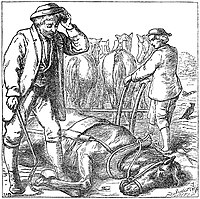Little Klaus and Big Klaus
Little Klaus and Big Klaus ( Danish : Lille Claus og Store Claus ) is an art fairy tale by the Danish writer Hans Christian Andersen .
content
The rich big Klaus who owns four horses and poor little Klaus who only owns one horse lives in a village . He lends that to big Klaus to plow during the week and in return receives his four horses for field work on Sunday. When people come by, little Klaus calls loudly and proudly: “Hush all my horses!” This annoys big Klaus so much that one day he kills the poor man's only horse. Sadly, he pulls the skin off the dead horse and wanders into town to sell it there. When night falls he reaches a farm. However, the farmer's wife shows him the door. So he climbs up on the roof of the shed to spend the night there. Then he notices how the woman inside is tending the sexton with roast meat, fish and wine. Soon you can hear the farmer returning home. Startled, the farmer's wife hides food and drinks and tells the sexton to hide in a chest. The farmer discovers little Klaus and invites him to his house. Klaus doesn't like the grits that have been applied . He steps on the sack with the horse skin so that it creaks loudly and pretends to the farmer that a magician is speaking in the sack who is conjuring up the food hidden from the farmer. Now people feast on roast and wine, and the landlord insolently demands that the "magician" conjure up the devil. Klaus lets the farmer take a look into the chest - he thinks he sees the devil in the ugly sexton and is now obsessed with the sack. Klaus sells it for a bushel of money. He also receives the chest with the "devil". When Klaus ponders out loud whether he should sink this into the deep river, the sexton still locked in buys his freedom with another bushel of money.
At home, little Klaus cunningly provides the great with knowledge of the wealth he has acquired by selling horse skin. So he kills his four horses. When he sells the hides in town for a bushel per hide, the shoemakers and tanners think he is crazy and beat him out into the village. Now he seeks revenge.
Little Klaus' grandmother has since died. He lays her in his bed because he believes its warmth will bring life back into her. In the dark of night, the big Klaus storms into the house and hits the figure in bed with his ax, convinced that he has now killed his adversary. But the next morning he drives away with the dead woman in the back seat. At an inn he asks the landlord to give the deaf old woman a drink outside in the car. When she doesn't react despite his screaming, he throws the glass in her face. The corpse falls to the ground and little Klaus accuses the landlord of having killed his grandmother. Horrified by his alleged act, he offers the grandson a bushel of money and to take over the funeral. Again, the great Klaus learns of this event. In his greed for money, the great Klaus kills his own grandmother and offers the corpse to the pharmacist for a bushel of money. He rebukes big Klaus, who only escapes arrest because people think he's crazy.
Now extremely angry, the big Klaus puts the little one in a sack to drown him in the river. On the way he passes a church. He decides to have a short prayer and leans the sack against the churchyard wall. Little Klaus complains that he has to go to heaven so young. This is heard by an old drover tired of life. At the prospect of reaching the Kingdom of Heaven today, he gives little Klaus his herd of cows and bulls and crawls into the sack. Big Klaus didn't notice anything about the exchange, throws the sack into the river and returns home. Later he was astonished to see little Klaus with a herd of magnificent cattle. He raved that he was received by friendly people at the bottom of the river. There are innumerable herds of the finest cattle there. He initially received this herd and is now on the way to fetch another herd from the river. Again the great Klaus mind succumbs to his greed. He asks little Klaus to immediately throw him into the river in a sack. He willingly fulfills this desire. Then he drives his flock home and mumbles, "I'm afraid he won't find the cattle."
Related works
The Bürle , a swank in the children's and house fairy tales of the Brothers Grimm from the 2nd edition of 1819 at position 61, was the model for the art fairy tale. A similar fairy tale can be found in the fairy tale collection of the Czech writer Božena Němcová .
Film adaptations
- Little and big Klaus , alternate. Title Klaus and Kläuschen (GDR / ČSSR, 1971)
- The big and the little Klaus , original title Mikola a Mikolka (ČSSR / BRD / I / E, 1988)
